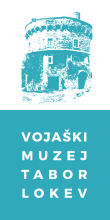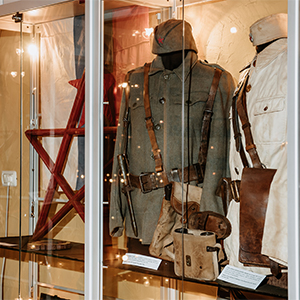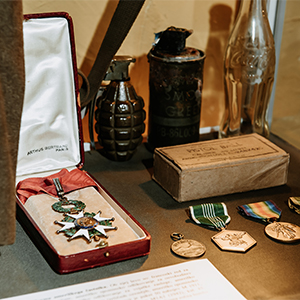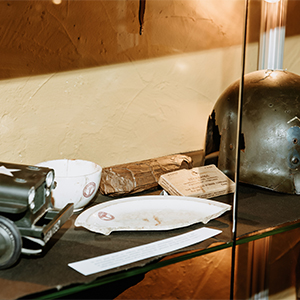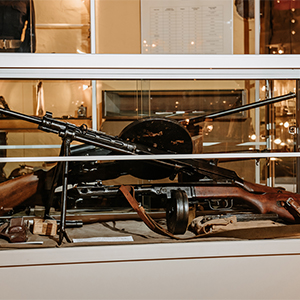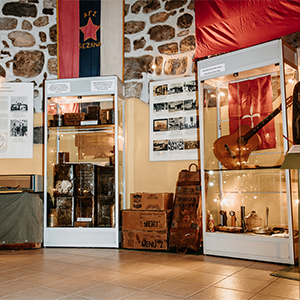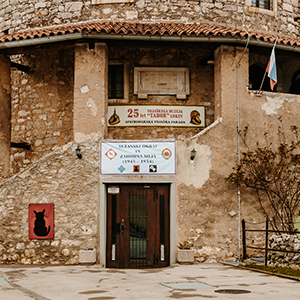Temporary exhibition
Sežana district and the western border (1945-1954)
The exhibition "Sežana District and the Western Border (1945–1954)" was created to celebrate the 76th anniversary of the annexation of the Primorska region to the motherland Slovenia which took place on 15th September 1947. The exhibition deals with the political situation, everyday life of the locals, culture and education in the Sežana district between 1945 and 1954 – from the time when, after the end of the Second World War, the area belonged to Zone A of the Julian March, under the Allied Military Government (AMG) until the first years after its annexation to the Federative People's Republic of Yugoslavia.
In the first years after the Second World War the district was greatly influenced by the dual government between the Anglo–American administration and the people's government under the National Liberation Committees which followed the directives of the Regional National Liberation Committee for the Slovenian Littoral and Trieste (RNLC) or in other words the communist Yugoslav authorities. The majority of the domestic population recognized the Allies as obstacles to their will to join Yugoslavia and as supporters of fascist laws, as the Allies largely left them in force. Allied administrative officers, the police and the army settled in several facilities in the Sežana district. The American 88th Infantry Division ‘Blue Devil’ occupied most parts of the Gorizia region and Trieste. Mainly English units (battalions) were stationed in the Sežana district and were rotating every few months. They were part of the 56th (London) Infantry Division–‘The Black Cats’ and the 6th Armoured Division (from July 1946 the 1st Armoured Division). Several times they occupied school buildings or buildings where the Italian and later the German government operated during the war. Sežana was also the headquarters of the civil police of the district, which, in addition to the British and American military police (Allied Military Police), ensured order and peace. The Civil Police, also called Venezia Giulia Police Force, had a rather bad reputation among the locals due to the use of batons during local demonstrations and manifestations. The older people from the Karst mostly remembered the Scots from their youth, who paraded along the main roads of the Karst villages every Sunday in kilts and played bagpipes. Interactions between the Allies and the natives in the countryside took place at fun events, when the Allies needed help (e. g. to borrow tools) and when the locals crossed the Morgan Line at a border crossing station. If they went to Zone B, where the Military Administration of the Yugoslav Army was, without a permit, they used an illegal route.
Many roads, water infrastructure, bridges, lighting, houses and other types of village buildings were renovated and improved in the Sežana district during zone A of the Julian March. In some cases, the people were paid for the work, but the villagers also did the repairs on a shift basis, free of charge.
In case of the schools, the popular authorities insisted on learning about the National Liberation Movement and displaying Tito's pictures and the Yugoslav flag, appointing teachers who were politically reliable, and using teaching materials that mentioned Yugoslavia, partisans, Tito, the victory of the National Liberation Movement, etc. AMG, on the other hand, tended towards apolitical, neutral schools, where to a greater extent they kept the laws from before the capitulation of Italy, with the exception of the use of the Slovene and Croatian language.
When the International Boundary Commission arrived in the spring of 1946 with the aim of determining the ethnic border between the Italianità and the ‘Slavness’, the locals decorated all the roads, houses and walls with slogans, triumphal arches and pictures in favour of Tito, Stalin and the National Liberation Movement. In the end, the members of the commission only made proposals that reflected the aspirations of the country from which certain members came, i.e. Great Britain, the USA, the USSR and France.
After the visit of the Boundary Commission and the Peace conference in Paris, which took place between 29th July and 15th October 1946, an agreement was reached regarding the Italian–Yugoslavian peace treaty. The provisions were finalized at a meeting of the Council of Foreign Ministers in New York in December 1946. On the 10th of February 1947, representatives of the Allied and Associated Powers signed a peace agreement with Italy in Paris on the establishment of the eastern border of the Republic of Italy and the western border of Yugoslavia as well as the establishment of the international entity called the Free Territory of Trieste (FTT). Idrija, Ilirska Bistrica, Sežana, Postojna, Tolmin and some areas of Gorizia have joined Yugoslavia. The treaty entered into force when the USSR, the USA, GB and France deposited their papers of ratification to the French government on 15th September 1947. Italy and Yugoslavia considered the treaty as a temporary solution that could be 'improved' in the future to their advantage. On the western side, the Sežana district bordered zone A of the Free Territory of Trieste for about seven years. In October 1954, the FTT was divided between Yugoslavia and Italy with the London Memorandum.
Despite the fact that the Sežana district 'got rid' of allied administration after joining Yugoslavia, the population remained cut off from Trieste, to which it was economically, culturally and emotionally very attached. In the early 1950s, a sense of neglect prevailed in the district, as there was no significant progress, for example in the area of living conditions and school buildings. Suspicion of the communist authorities towards the Catholic clergy also increased, but most locals remained firm in their faith.
